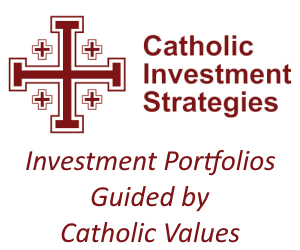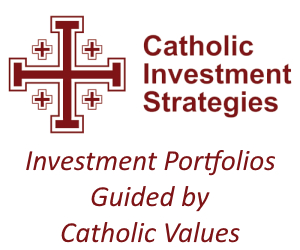Column: The Catholic Investor
The past days have seen the media launch an attack on an individual, Peter Hegseth, who President Trump has nominated for the cabinet level position of Defense Secretary. The condemnations arise from two tattoos he bears. I don’t know Mr. Hegseth, but I do know a reasonable amount about the tattoo designs.
Both of the tattoos harken back to the First Crusade. One, “Deus Vult”, literally translates to “God Wills It”. The phrase refers to the crusaders’ understanding that God wished them to reconquer the Holy Land, and Jerusalem in particular, which had fallen to the Seljuk Turks.
Which brings us to the second tattoo, the Jerusalem Cross, which is the graphic logo that we use on our website, business cards, and marketing material and can be seen above.
The Jerusalem Cross and the First Crusade in 1095
The Jerusalem Cross is often called the Crusader’s Cross because it was on the papal banner given to the crusaders by Pope Urban II at the start of the First Crusade in 1095. Pope Urban II wished the people of Europe to make a pilgrimage to the Holy Land. This turned into a Crusade to liberate all of the Churches in the “East”, meaning present day Turkey east of the Bosporus, Syria, Lebanon, and Israel. The Seljuk Turks, following their victories, closed, desecrated, converted, or destroyed the Churches in those lands.
Byzantine Emperor’s plea for help
The Pope was responding to a request from the Byzantine Emperor for help in repelling the advancing Turks. The first Crusade ended with the retaking of Jerusalem by the Crusaders. Godfrey of Bouillon, who led the first crusade and established the Kingdom of Jerusalem, used the cross as a symbol of his kingdom and his personal coat of arms.
Even today, if you travel through Israel, you will find, here and there, holy sites under the care of the Franciscan order flying white flags that are emblazoned with the Jerusalem Cross. Additionally, the cross is the emblem of the Latin Patriarch of Jerusalem.
Various Meanings of the Jerusalem Cross
There are various interpretations of the meaning of the Jerusalem Cross.
Some believe that it represents Christ’s command to spread the Gospel around the world; a mission that started in Jerusalem which is represented by the large, center cross. In this interpretation, the four small crosses represent the four corners of the world, to which the good news of the Gospel was to be preached.
Some see it as representing the Bible, with the Old Testament in the four Tau Crosses, those are the T’s that make up the center cross, and the New Testament’s four gospels in the smaller crosses.
Or the main cross may represent the idea of Christ as the center of creation, surrounded by the four evangelists; Matthew, Mark, Luke, and John.
Perhaps the Jerusalem cross was meant to graphically depict the five wounds suffered by Jesus during Calvary. The four small crosses signifying the piercing of His hands and feet by the nails of the crucifixion and the large central cross being the spear wound in Jesus’ side.
Lastly, some Christians in Jerusalem refer to this symbol as the Pilgrim’s Cross. In this tradition, the middle cross is the pilgrim, with the smaller crosses being those who support and pray for the pilgrim during his/her pilgrimage.
Recall that the 1st Crusade began as a pilgrimage to the Holy Land.
A potent symbol of the “Church militant”
Whichever interpretation of the Jerusalem Cross you favor, the undeniable fact is that it is a potent symbol of the “Church militant”, where that term means the faithful here on earth who are struggling against sin, the devil, and “the rulers of darkness of this world, against spiritual wickedness in high places” (Ephesians 6:12).
In the Jerusalem Cross we find much of what inspires us.
Our crusade at Catholic Investment Strategies
At Catholic Investment Strategies, we are on a crusade (small “C” intentional) to bring Catholic investors not only solid investment approaches that can lead to financial success, but investment approaches that combine those traits with the Catholic faith. 
The U.S. Conference of Catholic Bishops has published investment guidelines to help investors adhere to the tenets of Catholicism.
One of the prescriptions of the guidelines is to engage in active advocacy to bring about change for improvement in those companies which have stepped over certain moral boundaries but that, nonetheless, may be receptive to the possibility of change.
We believe that, by providing active advocacy to our investors’ portfolios, together we can help to create a better, more moral, country and world. Jesus contrasted his way to the way of the world quite emphatically: “He who is not with me is against me” (Luke 11:23).
St. Ignatius of Loyola’s Meditation on the Two Standards
St. Ignatius of Loyola (the founder of the Society of Jesus, the Jesuits) developed this into his “A Meditation on the Two Standards”—a “standard” meaning a flag. In that meditation, St. Ignatius tells us that we must choose where we are going to stand; with Jesus under His standard or with Satan under his.
No matter who we are, once we are baptized and confirmed, we are called to stand with Jesus under his flag. And what better flag, perhaps, than one emblazoned with the Jerusalem Cross?
As I said at the start, I don’t know Mr. Hegseth and I don’t know his motivations for having the tattoos at the heart of today’s particular media controversy. I have no reason to believe that he is motivated by anything other than a sincere love for Jesus, a desire to glorify Him, and a calling to “struggle against spiritual wickedness in high places”.
Thomas "Tom" Carroll, CFA, is the president of Catholic Investment Strategies, a position in which he has passionately enjoyed serving since 2012. Prior to this position,... MORE »




You must be logged in to post a comment.